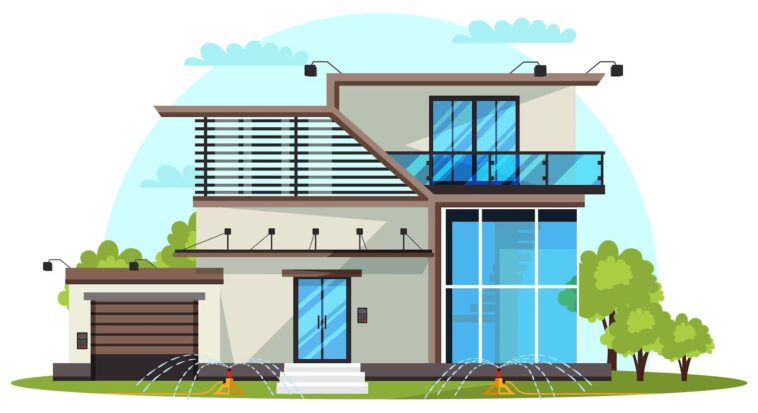The evolution of home design continues to fascinate us. Today, we are going to explore a specific type of residential architecture popular across the globe – the split level home. Particularly, we’ll delve into split level home designs in Australia and the best split level home designs one can find, with a particular focus on Victoria. This article will serve as an eye-opener to the unique advantages and the distinctive style of split level houses.
What is a Split Level House Design?
Before we plunge into the intricate details of the design elements, it’s crucial to understand what a split level house design actually is. A split level home is a style of house in which the floor levels are staggered, typically with the main living areas at street level, bedrooms a half-flight up and a basement level a half-flight down, often repurposed for living space or storage.
Split level designs emerged in the mid-20th century as a solution for building on hilly or uneven terrain, making the most of the available land and providing an innovative, functional living space. They are typically characterised by their multi-level layout and few steps between each floor, giving the house a unique flow.
Understanding Split Level Home Designs
Split level home designs have evolved significantly from their mid-century modern roots. Today’s architects and designers leverage the layout’s inherent versatility to create unique, engaging spaces. Here are a few ways that split level designs have evolved and what to expect from a modern split level home.
Efficient Use of Space
One of the main advantages of split level homes is the efficient use of space. The staggered floor plan means you can separate the different areas of the home without the need for long hallways or wasted space. It also provides a way to define spaces without closing them off, allowing for open, flowing layouts that still have clearly defined areas.
Adaptability to Land
Another advantage is the adaptability of split level home designs to various types of land. Whether the block is sloping, uneven, or hilly, a split level design can be tailored to suit the terrain. This makes them a particularly good choice for many areas in Australia, where uneven and sloping blocks are common.
Architectural Interest
Split level homes also offer an architectural interest that is unmatched by many other types of designs. The different levels can create an engaging and unique aesthetic, both internally and externally. It adds depth, dimension, and character to a home, making it stand out from traditional single or double-storey homes.
Split Level Home Designs Australia
Australia has a varied and diverse landscape, making it an ideal setting for split level homes. Architects and home builders across the country have embraced this design concept, creating unique and functional homes that make the most of Australia’s distinctive environment.
Embracing the Outdoors
Australian split level designs often take advantage of the country’s climate and natural beauty. Large windows, outdoor living areas and the integration of indoor and outdoor spaces are common features. The staggered design also allows for multiple vantage points to enjoy views and natural light.
Sustainable Design
Many split level designs in Australia focus on sustainability. This includes using natural materials, incorporating passive solar design principles, and using the site’s natural topography to reduce the need for excavation and retaining walls.
Spotlight on Split Level Home Designs Victoria
In Victoria, split level designs are particularly popular due to the state’s varied terrain. Designers and builders have adapted the split level design to create homes that are uniquely suited to the Victorian landscape and lifestyle.
Coastal Designs
Along the coast, split level designs maximise ocean views with large windows and elevated living areas. These homes often feature open-plan living spaces that flow out onto decks or balconies, allowing residents to make the most of the coastal lifestyle.
Bushland Homes
In bushland areas, split level homes often nestle into the landscape, minimising disruption to the natural environment. These homes use materials that blend into the surroundings and feature designs that embrace the bush views and tranquillity.
Best Split Level Home Designs
While there’s an abundance of great split level home designs out there, the best ones share a few key elements. They make efficient use of space, blend seamlessly with their surroundings, and provide functional and comfortable living spaces. Here are some aspects to look out for:
Innovative Layouts
The best split level designs offer innovative layouts that are tailored to the needs of the occupants. This might include flexible living spaces, secluded master suites, or integrated indoor/outdoor living areas.
Quality Materials
High-quality materials are a must in the best split level designs. Whether it’s durable exterior materials that can withstand the elements or luxurious interior finishes that add a touch of elegance, the materials used in a split level home play a major role in its overall appeal.
Attention to Detail
The best split level designs showcase meticulous attention to detail. This can be seen in the precision of the construction, the selection of fixtures and fittings, and the thoughtfulness of the layout.
In conclusion, split level home designs offer a unique and stylish alternative to traditional home designs. They are versatile, adaptable, and efficient, making them a popular choice in Australia, especially in Victoria. Whether you are a home builder, architect, or potential homeowner, understanding the beauty and functionality of split level designs can open up a new world of residential design possibilities.
Frequently Asked Questions on Split Level Home Designs
1. What is a split level house design?
A split level house is a style of architecture where the floor levels are staggered, typically with the main living areas at street level, bedrooms a half-flight up and a basement level a half-flight down.
2. What are the key characteristics of a split level home design?
Split level homes are characterised by their efficient use of space, adaptability to various types of land, and unique architectural interest. They often have an open, flowing layout with clearly defined areas, and are particularly suited to sloping, uneven, or hilly terrain.
3. What makes split level home designs popular in Australia?
The varied and diverse Australian landscape makes it an ideal setting for split level homes. These homes can efficiently utilise uneven or sloping blocks, and many designs take advantage of the country’s climate and natural beauty. Sustainable design elements are also frequently incorporated.
4. How are split level home designs adapted in Victoria?
In Victoria, coastal split level designs often maximise ocean views, with open-plan living spaces that flow onto outdoor areas. In bushland settings, split level homes may blend into the landscape, using materials that complement the natural environment and offering tranquil views.
5. What are the key elements of the best split level home designs?
The best split level designs offer innovative layouts tailored to the needs of the occupants, use high-quality materials both externally and internally, and showcase meticulous attention to detail in construction, fixtures, fittings, and layout planning.
6. Are split level home designs energy efficient?
Many split level designs in Australia incorporate principles of sustainable design, including the use of natural materials and passive solar design principles, making them energy efficient.
7. Are split level homes good for families?
Yes, split level homes can be great for families. The layout allows for clear separation of spaces (for example, bedrooms and living areas), which can be beneficial for families with children of different ages.
8. Do split level homes cost more to build?
The cost to build a split level home can vary widely based on factors like the complexity of the design, the materials used, and the specific conditions of the building site. While they may potentially cost more due to the complexity of construction, they can also offer cost savings by making efficient use of space and reducing the need for extensive excavation or land grading.




Comments
0 comments